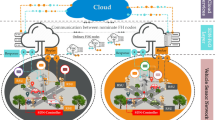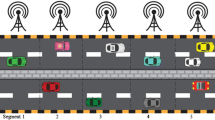Abstract
Vehicular ad hoc networks (VANETs) have received much attention from various parties in recent years. With the continuous development of VANETs and the generation of VANET applications, the study of network quality for VANETs becomes quite essential. In this paper, we use Average Network Flow (ANF) as a measure of the overall network quality of the city, and propose a tree-cut mapping-based average maximum flow solution method (TCMANF). TCMANF can quickly obtain the maximum flow of the network between the nodes and thus to determine the average network flow, which is better than the traditional maximum flow computation method in terms of time and the accuracy can be up to 99%, and it is suitable for the computation of urban vehicular networking networks. The article compares this with the use of an overall network capacity metric for urban vehicular networks approach and concludes that ANF can better reflect the impact of the discrete degree of vehicle topology on the overall network quality.









Similar content being viewed by others
Availability of data and code
Data sharing is not applicable to this article. We have put the algorithm involved in the article into GitHub, the link is as follows https://github.com/whxgood99/TCMANF.
References
Fraiji Y, Azzouz LB, Trojet W, Saidane LA (2018) Cyber security issues of internet of electric vehicles. PhD Thesis. https://doi.org/10.1109/WCNC.2018.8377181 . IEEE
Yinan J, Ruiying L, Ning H, Rui K (2012) Survey on network reliability evaluation methods. Computer Science 39(5):9–13. https://doi.org/10.3969/j.issn.1002-137X.2012.05.002
Chen J, Mao G, Li C, Liang W, Zhang D-G (2017) Capacity of cooperative vehicular networks with infrastructure support: Multiuser case. IEEE Trans Veh Technol 67(2):1546–1560. https://doi.org/10.1109/TVT.2017.2753772
Giang AT, Busson A, Lambert A, Gruyer D (2015) Spatial capacity of ieee 802.11 p-based vanet: models, simulations, and experimentations. IEEE Trans Veh Technol 65(8):6454–6467. https://doi.org/10.1109/TVT.2015.2474156
Peng Y, Luo T, Zhang H (2017) Transmission opportunity and capacity analysis for cellular based clustered vanet, pp 19–24. https://doi.org/10.1109/ICEIEC.2017.8076503 . IEEE
Ni M, Pan J, Cai L, Yu J, Wu H, Zhong Z (2015) Interference-based capacity analysis for vehicular ad hoc networks. IEEE Commun Lett 19(4):621–624. https://doi.org/10.1109/LCOMM.2015.2392117
He X, Hang Z, Shi W, Tao L, Beaulieu NC (2017) Transmission capacity analysis for linear vanet under physical model. China Commun 14(003):97–107. https://doi.org/10.1109/CC.2017.7897326
Guan X, Huang Y, Chen M, Wu H, Ohtsuki T, Zhang Y (2017) Exploiting interference for capacity improvement in software-defined vehicular networks. IEEE Access, pp 1–1. https://doi.org/10.1109/ACCESS.2017.2711003
Zhang G, Xu Y, Wang X, Tian X, Liu J, Gan X, Yu H, Qian L (2012) Multicast capacity for vanets with directional antenna and delay constraint. IEEE J Sel Areas Commun 30(4):818–833. https://doi.org/10.1109/JSAC.2012.120515
Xu W, Shi W, Lyu F, Zhou H, Cheng N, Shen X (2019) Throughput analysis of vehicular internet access via roadside wifi hotspot. IEEE Trans Veh Technol 68(4):3980–3991. https://doi.org/10.1109/TVT.2019.2900032
Cheng J, Yuan G, Zhou M, Gao S, Liu C, Duan H (2019) A fluid mechanics-based data flow model to estimate vanet capacity. IEEE Trans Intell Transp Syst 21(6):2603–2614. https://doi.org/10.1109/TITS.2019.2921074
Si W, Mburano B, Zheng WX, Qiu T (2022) Measuring network robustness by average network flow. IEEE Trans Netw Sci Eng 9(3):1697–1712. https://doi.org/10.1109/TNSE.2022.3150289
Ford LR, Fulkerson DR (1956) Maximal flow through a network. Can J Math 8:399–404. https://doi.org/10.4153/CJM-1956-045-5
Edmonds J, Karp RM (1972) Theoretical improvements in algorithmic efficiency for network flow problems. J ACM (JACM) 19(2):248–264. https://doi.org/10.1007/3-540-36478-1_4
Dinitz EA (1970) Algorithms for solution of a problem of maximum flow in a network with power estimation. Soviet Math Cokl
Liers F, Pardella G (2011) Simplifying maximum flow computations: The effect of shrinking and good initial flows. Discret Appl Math 159(17):2187–2203. https://doi.org/10.1016/j.dam.2011.06.030
Zhao S, Xu X, Hua B, Zhang Y (2012) Contraction network for solving maximum flow problem. In: Proceedings of the ACM SIGKDD Workshop on Mining Data Semantics, pp 1–6. https://doi.org/10.1145/2350190.2350198
Zhang Y, Xu X, Hua B, Zhao S (2012) Contracting community for computing maximum flow. In: 2012 IEEE International Conference on Granular Computing, pp 651–656. https://doi.org/10.1109/GrC.2012.6468649 . IEEE
Wei W, Liu Y, Zhang R (2018) Splmax: exploiting the simple path introduced locality for maximum flow acceleration. IEEE Commun Lett 22(7):1330–1333. https://doi.org/10.1109/LCOMM.2018.2830786
Goldberg AV, Tarjan RE (2014) Efficient maximum flow algorithms. Commun ACM 57(8):82–89. https://doi.org/10.1145/2628036
Tao H, Wei H, Jun D, Yong Z, Yang Y, Xiaohu G (2021) Connectivity analysis of lov based on scale-free network. J Commun 42(4):100–108. https://doi.org/10.11959/j.issn.1000-436x.2021101
Acknowledgements
This paper was supported by the National Natural Science Foundation of China (Project No. 62172141), Analysis and optimization of network capacity under V2V/V2R hybrid communication mode in Internet of Vehicles.
Funding
No funding was received to assist with the preparation of this manuscript.
Author information
Authors and Affiliations
Contributions
Haoxiang Wang: Conceptualization, Formal analysis, Writing - original draft. Weidong Yang: Visualization, Investigation, Writing - review & editing. Wei Wei: Methodology, Writing - review & editing.
Corresponding author
Ethics declarations
Ethics approval
The paper is not currently being considered for publication elsewhere. The manuscript does not associate with any kind of humans/animals in this research.
Consent for publication
Not applicable.
Competing interests
The authors declare no competing interests.
Additional information
Publisher's Note
Springer Nature remains neutral with regard to jurisdictional claims in published maps and institutional affiliations.
Rights and permissions
Springer Nature or its licensor (e.g. a society or other partner) holds exclusive rights to this article under a publishing agreement with the author(s) or other rightsholder(s); author self-archiving of the accepted manuscript version of this article is solely governed by the terms of such publishing agreement and applicable law.
About this article
Cite this article
Wang, H., Yang, W. & Wei, W. Efficient algorithms for urban vehicular Ad Hoc networks quality based on average network flows. Peer-to-Peer Netw. Appl. 17, 115–124 (2024). https://doi.org/10.1007/s12083-023-01581-y
Accepted:
Published:
Issue Date:
DOI: https://doi.org/10.1007/s12083-023-01581-y




